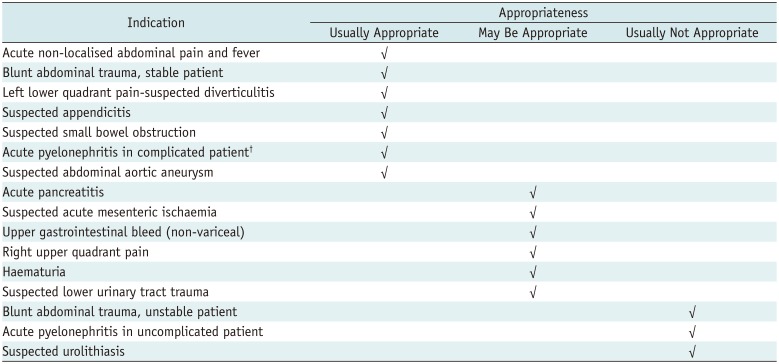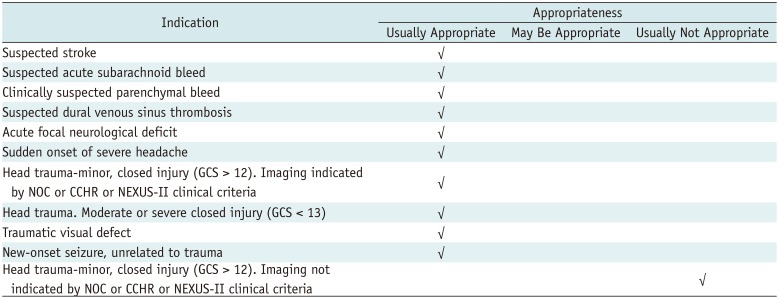1. Liebeskind DS, Jahan R, Nogueira RG, Jovin TG, Lutsep HL, Saver JL. Early arrival at the emergency department is associated with better collaterals, smaller established infarcts and better clinical outcomes with endovascular stroke therapy: SWIFT study. J Neurointerv Surg. 2016; 8:553–558. PMID:
25964375.

2. Cullen L, Greenslade JH, Menzies L, Leong A, Than M, Pemberton C, et al. Time to presentation and 12-month health outcomes in patients presenting to the emergency department with symptoms of possible acute coronary syndrome. Emerg Med J. 2016; 33:390–395. PMID:
26781459.

3. Larson DB, Johnson LW, Schnell BM, Salisbury SR, Forman HP. National trends in CT use in the emergency department: 1995-2007. Radiology. 2011; 258:164–173. PMID:
21115875.

4. Fazel R, Krumholz HM, Wang Y, Ross JS, Chen J, Ting HH, et al. Exposure to low-dose ionizing radiation from medical imaging procedures. N Engl J Med. 2009; 361:849–857. PMID:
19710483.

5. Raja AS, Ip IK, Sodickson AD, Walls RM, Seltzer SE, Kosowsky JM, et al. Radiology utilization in the emergency department: trends of the past 2 decades. AJR Am J Roentgenol. 2014; 203:355–360. PMID:
25055271.

6. Huber-Wagner S, Lefering R, Qvick LM, Körner M, Kay MV, Pfeifer KJ, et al. Working Group on Polytrauma of the German Trauma Society. Effect of whole-body CT during trauma resuscitation on survival: a retrospective, multicentre study. Lancet. 2009; 373:1455–1461. PMID:
19321199.
7. Millet I, Sebbane M, Molinari N, Pages-Bouic E, Curros-Doyon F, Riou B, et al. Systematic unenhanced CT for acute abdominal symptoms in the elderly patients improves both emergency department diagnosis and prompt clinical management. Eur Radiol. 2017; 27:868–877. PMID:
27271919.

8. Barber PA, Demchuk AM, Zhang J, Buchan AM. Validity and reliability of a quantitative computed tomography score in predicting outcome of hyperacute stroke before thrombolytic therapy. ASPECTS Study Group. Lancet. 2000; 355:1670–1674. PMID:
10905241.
9. Wildermuth S, Knauth M, Brandt T, Winter R, Sartor K, Hacke W. Role of CT angiography in patient selection for thrombolytic therapy in acute hemispheric stroke. Stroke. 1998; 29:935–938. PMID:
9596238.

10. Morgan DJ, Dhruva SS, Coon ER, Wright SM, Korenstein D. 2017 update on medical overuse: a systematic review. JAMA Intern Med. 2018; 178:110–115. PMID:
28973402.
11. Griffey RT, Sodickson A. Cumulative radiation exposure and cancer risk estimates in emergency department patients undergoing repeat or multiple CT. AJR Am J Roentgenol. 2009; 192:887–892. PMID:
19304691.

12. Levin DC, Rao VM, Parker L, Frangos AJ, Sunshine JH. Recent shifts in place of service for noninvasive diagnostic imaging: have hospitals missed an opportunity? J Am Coll Radiol. 2009; 6:96–99. PMID:
19179236.

13. Rosenkrantz AB, Hanna TN, Babb JS, Duszak R Jr. Changes in emergency department imaging: perspectives from national patient surveys over two decades. J Am Coll Radiol. 2017; 14:1282–1290. PMID:
28483547.

14. Hu SY, Hsieh MS, Lin MY, Hsu CY, Lin TC, How CK, et al. Trends of CT utilisation in an emergency department in Taiwan: a 5-year retrospective study. BMJ Open. 2016; 6:e010973.

15. Tung M, Sharma R, Hinson JS, Nothelle S, Pannikottu J, Segal JB. Factors associated with imaging overuse in the emergency department: a systematic review. Am J Emerg Med. 2018; 36:301–309. PMID:
29100783.

16. Ditkofsky N, Shekhani HN, Cloutier M, Chen ZN, Zhang C, Hanna TN. Ionizing radiation knowledge among emergency department providers. J Am Coll Radiol. 2016; 13:1044–1049.e1. PMID:
27162040.

17. Divrik Gökçe S, Gökçe E, Coşkun M. Radiology residents' awareness about ionizing radiation doses in imaging studies and their cancer risk during radiological examinations. Korean J Radiol. 2012; 13:202–209. PMID:
22438688.

18. Lee CI, Haims AH, Monico EP, Brink JA, Forman HP. Diagnostic CT scans: assessment of patient, physician, and radiologist awareness of radiation dose and possible risks. Radiology. 2004; 231:393–398. PMID:
15031431.

19. Takakuwa KM, Estepa AT, Shofer FS. Knowledge and attitudes of emergency department patients regarding radiation risk of CT: effects of age, sex, race, education, insurance, body mass index, pain, and seriousness of illness. AJR Am J Roentgenol. 2010; 195:1151–1158. PMID:
20966321.

20. Gimbel RW, Fontelo P, Stephens MB, Olsen CH, Bunt C, Ledford CJ, et al. Radiation exposure and cost influence physician medical image decision making: a randomized controlled trial. Med Care. 2013; 51:628–632. PMID:
23604013.
21. Raja AS, Ip IK, Prevedello LM, Sodickson AD, Farkas C, Zane RD, et al. Effect of computerized clinical decision support on the use and yield of CT pulmonary angiography in the emergency department. Radiology. 2012; 262:468–474. PMID:
22187633.

22. Ip IK, Raja AS, Gupta A, Andruchow J, Sodickson A, Khorasani R. Impact of clinical decision support on head computed tomography use in patients with mild traumatic brain injury in the ED. Am J Emerg Med. 2015; 33:320–325. PMID:
25572644.

23. Lam DL, Larson DB, Eisenberg JD, Forman HP, Lee CI. Communicating potential radiation-induced cancer risks from medical imaging directly to patients. AJR Am J Roentgenol. 2015; 205:962–970. PMID:
26295534.

24. Bautista AB, Burgos A, Nickel BJ, Yoon JJ, Tilara AA, Amorosa JK. Do clinicians use the American College of Radiology appropriateness criteria in the management of their patients? AJR Am J Roentgenol. 2009; 192:1581–1585. PMID:
19457821.

25. Goo HW. CT radiation dose optimization and estimation: an update for radiologists. Korean J Radiol. 2012; 13:1–11. PMID:
22247630.

26. Malone J, Guleria R, Craven C, Horton P, Järvinen H, Mayo J, et al. Justification of diagnostic medical exposures: some practical issues. Report of an International Atomic Energy Agency Consultation. Br J Radiol. 2012; 85:523–538. PMID:
21343316.

27. Moskowitz H, Sunshine J, Grossman D, Adams L, Gelinas L. The effect of imaging guidelines on the number and quality of outpatient radiographic examinations. AJR Am J Roentgenol. 2000; 175:9–15. PMID:
10882239.

28. Ramsay CR, Eccles M, Grimshaw JM, Steen N. Assessing the long-term effect of educational reminder messages on primary care radiology referrals. Clin Radiol. 2003; 58:319–321. PMID:
12662955.

29. Brix G, Nagel HD, Stamm G, Veit R, Lechel U, Griebel J, et al. Radiation exposure in multi-slice versus single-slice spiral CT: results of a nationwide survey. Eur Radiol. 2003; 13:1979–1991. PMID:
12687286.









 PDF
PDF ePub
ePub Citation
Citation Print
Print



 XML Download
XML Download